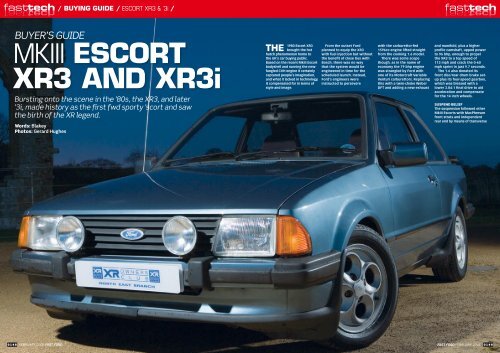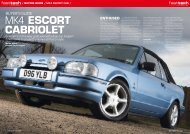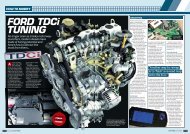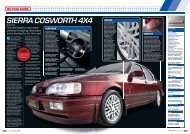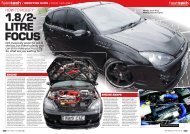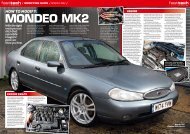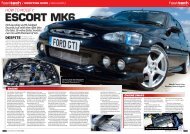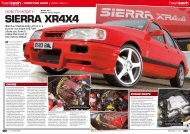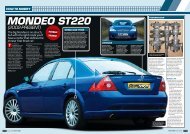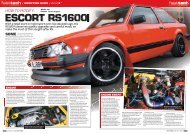Create successful ePaper yourself
Turn your PDF publications into a flip-book with our unique Google optimized e-Paper software.
fasttech / BUYING GUIDE / <strong>ESCORT</strong> <strong>XR3</strong> & ’3i / fasttech<br />
BUYER’S GUIDE<br />
<strong>MKIII</strong> <strong>ESCORT</strong><br />
<strong>XR3</strong> <strong>AND</strong> <strong>XR3</strong>i<br />
Bursting onto the scene in the ’80s, the <strong>XR3</strong>, and later<br />
’3i, made history as the first fwd sporty ’scort and saw<br />
the birth of the XR legend.<br />
Words: Blakey<br />
Photos: Gerard Hughes<br />
THE<br />
1980 Escort <strong>XR3</strong><br />
brought the hot<br />
hatch phenomenon home to<br />
the UK’s car buying public.<br />
Based on the recent MkIII Escort<br />
bodyshell and running the newfangled<br />
CVH engine it certainly<br />
captured people’s imagination,<br />
and what it lacked in technology,<br />
it compensated for in terms of<br />
style and image.<br />
From the outset <strong>Ford</strong><br />
planned to equip the <strong>XR3</strong><br />
with fuel injection but without<br />
the benefit of close ties with<br />
Bosch, there was no way<br />
that the system would be<br />
engineered in time for the<br />
scheduled launch. Instead,<br />
<strong>Ford</strong>’s engineers were<br />
instructed to persevere<br />
with the carburettor-fed<br />
1596cc engine lifted straight<br />
from the cooking 1.6 model.<br />
There was some scope<br />
though, as in the name of<br />
economy the 79 bhp engine<br />
was strangled by <strong>Ford</strong> with<br />
one of its Motorcraft Variable<br />
Venturi carburettors. Replacing<br />
this with a twin-choke Weber<br />
DFT and adding a new exhaust<br />
and manifold, plus a higher<br />
profile camshaft, upped power<br />
to 96 bhp, enough to propel<br />
the <strong>XR3</strong> to a top speed of<br />
113 mph and crack the 0-60<br />
mph sprint in just 9.7 seconds.<br />
The 1.6 also donated its<br />
front disc/rear drum brake setup<br />
plus its four-speed gearbox,<br />
which was blessed with a<br />
lower 3.84:1 final drive to aid<br />
acceleration and compensate<br />
for the 14 inch wheels.<br />
SUSPEND BELIEF<br />
The suspension followed other<br />
MkIII Escorts with MacPherson<br />
front struts and independent<br />
rear end by means of transverse<br />
0 1 4 8 FEBRUARY 2006 FAST FORD FAST FORD FEBRUARY 2006<br />
0 1 4 9
fasttech / BUYING GUIDE / <strong>ESCORT</strong> <strong>XR3</strong> & ’3i / fasttech<br />
“ Almost at once<br />
the XR was a<br />
sales smash.”<br />
arms with longitudinal links, but<br />
the springs and dampers were<br />
vastly uprated.<br />
Bilstein provided the gas-filled<br />
dampers and the rear springs<br />
were of the progressive kind,<br />
matching those on the Escort<br />
Spoiler on the front valence<br />
is unique to the car<br />
estate, but then progressing to<br />
double in stiffness as the load<br />
increased.<br />
Unsurprisingly, the <strong>XR3</strong> handled<br />
superbly on the flat but the ride<br />
was bone-shaking on a B-road. A<br />
Four-dial or ‘cloverleaf’<br />
alloys gave the<br />
<strong>XR3</strong> its distinctive<br />
’80s looks. They’re<br />
still easy to find<br />
second-hand<br />
thicker 22 mm anti-roll bar was<br />
specified on the front but <strong>Ford</strong><br />
reasoned there was no need for<br />
any on the back, pointing out that<br />
60 per cent of the car’s weight<br />
was sat over the front wheels.<br />
FORM <strong>AND</strong> FUNCTION<br />
Generous grip was offered by<br />
the 5.5x14 inch alloys, but their<br />
function was overshadowed<br />
by how they looked. A key<br />
component in the XR’s eyecatching<br />
appearance, the radical<br />
four-dial wheels were the perfect<br />
compliment to the XR’s striking<br />
matt black body extensions.<br />
These consisted of a rubber<br />
spoiler that wrapped around the<br />
wings and front valance, a pair of<br />
rear arch spats and a large spoiler<br />
on the rear tailgate.<br />
They weren’t just for show<br />
either, keeping the aerodynamics<br />
down to a figure of 0.375 Cd and<br />
offsetting the drag from the wider<br />
rims. To top off the exterior, the<br />
window surrounds were finished<br />
in matt black and the door mirrors<br />
plus the metal sections of the<br />
bumpers were colour-coded.<br />
Inside looked cool with stripy<br />
sports seats and nice touches<br />
like the two-spoke steering<br />
wheel, 140 mph speedo and<br />
internal adjustment for the<br />
door mirrors.<br />
SUCCESS STORY<br />
Almost at once the XR was a<br />
sales smash and aside from<br />
a few tweaks it remained<br />
largely unchanged until spring<br />
1982, when <strong>Ford</strong> succumbed<br />
to pressure and added a fifth<br />
gear, instantly improving fuel<br />
consumption and high-speed<br />
cruising ability.<br />
But the five-speed box was<br />
just a taster of what was to<br />
come for the XR enthusiast.<br />
<strong>Ford</strong> decided to continue on<br />
its quest for fuel injection and<br />
introduced the Bosch K-Jetronicequipped<br />
<strong>XR3</strong>i in October 1982,<br />
choosing to delete the <strong>XR3</strong> at<br />
the same time.<br />
Aside from the different badge<br />
there was little to differentiate<br />
between the two models, but<br />
the <strong>XR3</strong>i was so much more<br />
than just an added ‘i’.<br />
INFORMATION<br />
Body condition is<br />
all-important when<br />
looking at a car. You’re<br />
better off buying one<br />
with a clean shell and<br />
knackered engine<br />
rather than the other<br />
way round<br />
HPI<br />
The majority of early <strong>XR3</strong>s will need<br />
some intensive care. So if you’re<br />
going down the major resto route you<br />
don’t want to be ploughing time and<br />
money into an example that’s a<br />
wrong ‘un as well as rotten.<br />
Find out if the XR has been written<br />
off, stolen, or has outstanding finance<br />
on it by running an HPI check. Cost is<br />
£39.99 and the Escort can be checked<br />
out over the phone on 01722 422422<br />
or online at www.hpi.check.com.<br />
There can be as much as £2K<br />
between a tidy XR and a mint one, so<br />
to make sure you’re getting the latter,<br />
consider an independent inspection.<br />
As well as the engine changes,<br />
the new model featured revised<br />
suspension, a plusher interior<br />
with new trim and three-spoke<br />
steering wheel, plus the 4.29:1<br />
final drive and larger rear drum<br />
brakes from the Escort van, the<br />
former strengthened to cope with<br />
the <strong>XR3</strong>i’s higher power output of<br />
105 bhp.<br />
Top speed increased to 116<br />
mph and 0-60 mph acceleration<br />
was slashed to just 8.5 seconds,<br />
finally making the Escort a real<br />
GTi rival. As with the <strong>XR3</strong>, the<br />
<strong>XR3</strong>i proved immensely popular,<br />
selling over 25,000 alone in<br />
The RAC will complete an<br />
Essentials Plus inspection for<br />
£206.95, or £185.95 for members.<br />
There’s also the option of the cheaper<br />
Essentials check, which covers<br />
structural condition and major<br />
mechanicals. Contact the RAC on<br />
0870 5333660 or www.rac.co.uk.<br />
INSURANCE<br />
Mark is 22-year-old panel beater from<br />
Luton. He reckons he’s replaced the<br />
rear arches on every MkII Astra GTE in<br />
the land of the Griffin, so for his own<br />
enjoyment he’s blown £1500 on a very<br />
nice 1985 <strong>XR3</strong>i. He keeps the Cat 2alarmed<br />
XR garaged and he has four<br />
<strong>XR3</strong>s came blessed<br />
with Bilstein dampers,<br />
though it’s unlikely<br />
they’ll still be on<br />
the car<br />
1983. All things considered, it’s<br />
surprising then that survivors of<br />
both models are so thin on the<br />
ground. But, they are still out<br />
there if you’re prepared to look<br />
and now’s your chance to save a<br />
national icon and bag a bargain<br />
bit of fast <strong>Ford</strong> history.<br />
Just £1000 will secure a tidy<br />
example of either XR and you<br />
can rest assured that you’ll<br />
be enjoying a pure hot hatch<br />
experience — one where traction<br />
control and air con are for wimps<br />
and real men get by with just a<br />
digital roof clock and a flip-out<br />
cassette holder.<br />
years NCB. Mark pays £1289.07 to<br />
insure his <strong>XR3</strong>i fully comprehensive or<br />
£428.47 for third party, fire and theft<br />
cover. Insurance quote provided by<br />
www.quotelinedirect.com.<br />
CLUB<br />
XR Owners’ Club<br />
XROC HQ, Cope Place<br />
Earls Court Road<br />
Kensington<br />
London<br />
W8 6AA<br />
www.xroc.co.uk<br />
<strong>Ford</strong> Escort Owners’ Club<br />
www.feoc-uk.com<br />
TECH SPEC<br />
<strong>MKIII</strong> <strong>ESCORT</strong> <strong>XR3</strong><br />
ENGINE<br />
Type: CVH<br />
Capacity: 1596cc<br />
Bore/stroke: 79.96 mm x 79.52 mm<br />
Compression ratio: 9.5:1<br />
Max power: 96 bhp @ 6000 rpm<br />
Max torque: 98 Ibf.ft @ 4000 rpm<br />
Cylinders: four, in-line<br />
Cylinder head: cast aluminium<br />
Block: cast iron<br />
Installation: frontmounted<br />
transverse<br />
Valve gear: two valves per cylinder,<br />
single overhead camshaft, rockers,<br />
hydraulic tappets<br />
Fuelling: single downdraught dual<br />
choke Weber DFT carburettor<br />
Induction: single Weber twin-choke<br />
downdraught carburettor<br />
TRANSMISSION<br />
Type: fwd<br />
Gearbox: four-speed manual<br />
Internal ratios: 1st, 3.15; 2nd,<br />
1.91; 3rd, 1.27; 4th, 0.95; reverse,<br />
3.61; final drive, 3.84:1<br />
Clutch: 200 mm single-plate clutch<br />
SUSPENSION<br />
Front: independent by coil springs,<br />
MacPherson struts, 22 mm anti-roll<br />
bar and Bilstein telescopic dampers<br />
Rear: independent via transverse<br />
arms with longitudinal location links,<br />
separately mounted coil springs,<br />
Bilstein telescopic dampers<br />
STEERING<br />
Type: rack-and-pinion<br />
Lock-to-lock: 3.7 turns<br />
BRAKES<br />
System: diagonally-split<br />
twin-circuits with vacuum<br />
servo assistance<br />
Front: 9.4 inch (239.5 mm)<br />
ventilated discs<br />
Rear: 7.0 x1.5 inch<br />
(178x38 mm) drums<br />
WHEELS & TYRES<br />
Wheels: four-perforation cast alloys,<br />
5.5x14 inch<br />
Tyres: 185/60 HR<br />
BODY<br />
Type: pressed-steel monocoque,<br />
based on conventional three-door<br />
Escort hatch<br />
PERFORMANCE<br />
Max speed: 113 mph<br />
0-60 mph: 9.7 seconds<br />
0 1 5 0 FEBRUARY 2006 FAST FORD FAST FORD FEBRUARY 2006<br />
0 1 5 1
fasttech / BUYING GUIDE / <strong>ESCORT</strong> <strong>XR3</strong> & ’3i / fasttech<br />
CHECKLIST<br />
INTERIOR<br />
Basic, especially on <strong>XR3</strong>s, but the inside<br />
of the Escort is quite hard wearing if it<br />
has been treated with respect. After 20<br />
years though it’s inevitable that it will<br />
have seen some action.<br />
Usually it’s the seats that will show<br />
the biggest damage with sagging<br />
bolsters and torn cloth on the edges.<br />
Good, replacement second-hand ones<br />
are hard to find but it’s possible to buy<br />
a reproduction version of the early<br />
Laser fabric off the roll from some<br />
trim specialists.<br />
TRANSMISSION<br />
Little more than a beefed-up version<br />
of an early Fiesta box, the BC-type<br />
transmission, whether in four-speed<br />
or overdriven five-speed form, can still<br />
comfortably cope with the power of the<br />
<strong>XR3</strong> and <strong>XR3</strong>i.<br />
The fact that neither XR is particularly<br />
torquey helps to keep the box alive, but<br />
years of enthusiastic use are likely to<br />
have had some impact. Gear change<br />
quality was never the best, although<br />
the four-speed is considered to be the<br />
smoother shifting box, but a sloppy<br />
action indicates that the linkage is<br />
shot, while any crunching means<br />
the synchro is past its best.<br />
Generally, second and third<br />
gears lose synchro first. The<br />
clutch is a pretty puny 8 inch item<br />
so ensure it engages properly and check<br />
there’s no slippage by trying to pull away<br />
in third gear — it’s knackered if the XR<br />
doesn’t stall.<br />
Spring ’82-onwards cars<br />
came with five-speeder<br />
ENGINE IDENTITY<br />
In either injected or carburettor form the 1596cc engine is a<br />
reliable and willing performer. The CVH is more than capable of<br />
a six-figure mileage but only if it’s been well maintained with<br />
regular oil changes.<br />
The hydraulic lifters sludge up, killing the cam first and<br />
paving the way for accelerated engine wear — a rattle from<br />
the top end and blue smoke from oil being burnt in the<br />
combustion chambers are the obvious signs that the CVH<br />
is about to die. Look out for cambelt changes in the history<br />
too as if it goes west it’s not unusual for it to wipe out the<br />
whole engine.<br />
Both fuelling methods are reliable but think twice about a<br />
car that’s running a bit rough — the ‘3i’s K-Jetronic fuel<br />
injection is relatively simple but sorting out any problems is<br />
best left to the experts, while sound second-hand Weber DFTs<br />
carburettors are hard to find. Another thing to be aware of is<br />
that the distributors on <strong>XR3</strong>is suffer from weak springs,<br />
leading to full advance coming too early.<br />
The light coloured Monza trim and<br />
fleck door panels of later cars are prone<br />
to staining, but the biggest headache<br />
will be finding an XR with a crack-free<br />
dashboard. Over time, exposure to the<br />
sun causes the dash top to crack and as<br />
well as being a pain to replace it’s also<br />
costly — good, used dashes can change<br />
hands for upwards of £150.<br />
The plastic door bins of early <strong>XR3</strong>s are<br />
also prone to damage and tend to break<br />
off where they’re screwed into the door<br />
and onto the trim panel.<br />
Good trim’s all-important.<br />
As is a crack-free dash...<br />
Carb or fuel injection-fed,<br />
the 1.6 CVH is a good ’un<br />
BRAKES<br />
In relation to braking ability versus<br />
performance, the <strong>XR3</strong> and <strong>XR3</strong>i<br />
have the best brakes of a sporting<br />
MkIII Escort.<br />
Both XR models use a simple but<br />
effective disc/drum set-up (<strong>XR3</strong>i<br />
versions having slightly larger rear<br />
drums from the Escort van),<br />
which is<br />
Perhaps one of the most stolen cars ever, it’s<br />
essential to thoroughly check the car’s identity. The<br />
all-important numbers can be found in <strong>Ford</strong>’s favourite<br />
places — on the slam panel and under a flap in the<br />
carpet between the sill and driver’s seat. Look for iffy<br />
uneven numbers and signs of welding. Find out when<br />
the significant changes were made and see if they tally<br />
with the date of registration — five-speed box on a<br />
1980 <strong>XR3</strong>, then it’s a retro fit or something’s amiss...<br />
It may be 20-years-old, but you<br />
still need to check the VIN plate<br />
known to be largely reliable. As<br />
usual though, front discs are prone<br />
to warping — evident by judder<br />
through the steering wheel — and<br />
weeping rear cylinders, which are<br />
highlighted by brake fluid seeping<br />
onto the drum’s surface and an<br />
inefficient handbrake due to soaked<br />
brake shoes. The good news is that<br />
all brake components are dirt cheap<br />
and available from any decent<br />
motor factors.<br />
Dampers and springs take a<br />
beating: check each corner<br />
Unlike the Series 1, stock<br />
<strong>XR3</strong> brakes were plenty good<br />
Luxuries? This was all<br />
you got as standard!<br />
BODY<br />
Plenty have been written-off over the years but<br />
rust is the biggest killer of the XR. The MkIII shell<br />
can be a real rotter and with the earliest cars<br />
having just turned 25 years old, it’s rare to find an<br />
example that hasn’t got any grot.<br />
Prime spots are the chassis rails and battery<br />
tray, but check virtually everywhere including the<br />
inner wings, bulkhead, floorpan, sills and the<br />
boot floor. Genuine <strong>Ford</strong> panels are near extinct<br />
but it’s still possible to get repair sections,<br />
bumpers and some complete panels from a<br />
specialist like Hadrian.<br />
Reproduction decal kits are also available and<br />
there seems to be a good and steady supply of<br />
XR bodykit mouldings on eBay. These are<br />
generally cheap so it’s a good haggling point if<br />
the car you’re looking at is missing its rear spats<br />
or only has one section of the front spoiler. The<br />
Cloverleaf alloys also turn up regularly on eBay<br />
and don’t cost the earth.<br />
SUSPENSION<br />
ELECTRICS<br />
Not much to worry about really, the<br />
<strong>XR3</strong>’s only electrical luxury being a<br />
roof-mounted LED clock! Early<br />
<strong>XR3</strong>s with the optional fogs, central<br />
locking and electric windows are<br />
worth paying extra for so make<br />
sure that these are working<br />
correctly, if fitted. Don’t forget to<br />
check their operation on <strong>XR3</strong>is too,<br />
which featured much of this<br />
equipment as standard.<br />
Check out the underbonnet<br />
area, and look for frayed wiring<br />
and botched alarm installs — it’s<br />
not unusual to find an XR with<br />
an ancient non-operative alarm<br />
and immobiliser.<br />
The <strong>XR3</strong> and <strong>XR3</strong>i handle quite differently. The <strong>XR3</strong>’s spring rates<br />
make it superb on smooth surfaces but bumpy on anything else,<br />
while the <strong>XR3</strong>i is much more of an all-rounder, handling and<br />
riding well in all conditions.<br />
In standard trim a well-sprung early <strong>XR3</strong> will look slightly<br />
nose-up with the rear wheels showing a lot of negative camber<br />
and the fronts slightly bowed-in. In contrast, an <strong>XR3</strong>i will sit flat,<br />
an inch lower, and with no obvious wheel camber.<br />
Dampers and springs take a beating so bounce each corner<br />
of the car to check the rebound action and listen for any<br />
banging or clonking noises that could point to a snapped spring<br />
— especially if the car proves to be a handful under heavy<br />
braking and cornering.<br />
Check around the mounting points of the TCAs too as pre-<br />
1985 Escorts are known to suffer from the slightest of cracks in<br />
this area.<br />
0 1 5 2 FEBRUARY 2006 FAST FORD FAST FORD FEBRUARY 2006<br />
0 1 5 3
BUYING ONE<br />
Despite selling in their droves, it<br />
actually seems that buying a decent<br />
<strong>XR3</strong> or ’3i is considerably harder than<br />
securing a tidy S1 RS Turbo.<br />
Numbers of the XR have dwindled<br />
and it’s no surprise. While they are<br />
sound performers in their own right,<br />
enthusiasts have generally plumped<br />
for the aforementioned S1 or the<br />
RS1600i homologation special, using<br />
the XR as a stepping stone until<br />
funds become available for the latter<br />
models or bypassing it altogether.<br />
Like the MkII XR2, the <strong>XR3</strong> and<br />
its injected sibling have started to<br />
amass the mainstream recognition<br />
they deserve. As always there are<br />
a few optimistically priced cars, but<br />
by and large prices for the XRs have<br />
remained down to earth — even<br />
in the face of the growing ‘80s hot<br />
hatch revival.<br />
Paying for one isn’t a problem,<br />
but finding an early XR can be. The<br />
majority are in various states of<br />
disrepair and these neglected cars<br />
tend to appear in the usual suspects<br />
such as Trade-it, Loot and eBay.<br />
The free classifieds in <strong>Fast</strong> <strong>Ford</strong><br />
are worth scouring too, although<br />
the model’s classic status means a<br />
check of the small ads in sister titles<br />
Retro Cars and Classic <strong>Ford</strong> may<br />
prove more fruitful.<br />
Good to top end stuff does appear<br />
in Auto Trader, but a fine place to<br />
start looking is the classified section<br />
of the XR Owners’ Club website.<br />
When we looked the pick of the<br />
bunch was a 1982 <strong>XR3</strong> in original<br />
condition and finished in Sunburst<br />
Red. Up for a grand, it wasn’t a<br />
bargain but to its credit it had never<br />
been welded and came with a fresh<br />
MoT and a load of new parts.<br />
At the opposite end of the<br />
spectrum the Classic <strong>Ford</strong> small<br />
ads unearthed an early 1986 <strong>XR3</strong>i for £250,<br />
which had been stood for eight<br />
years, while eBay listed a couple<br />
of Sunburst Red <strong>XR3</strong> projects,<br />
eventually selling for £380 and £250.<br />
The most expensive we found<br />
was in Auto Trader — a 1985 Cplate<br />
<strong>XR3</strong>i with decent history,<br />
a new MoT and described as<br />
immaculate. It looked a potential<br />
show car but the £2500 asking<br />
price was very strong.<br />
Auto Trader also revealed a<br />
late five-speed <strong>XR3</strong> with desirable<br />
options and a recent engine rebuild<br />
<strong>XR3</strong> and MkIII <strong>XR3</strong>i are<br />
now bona fide classics<br />
“Numbers of the XR<br />
have dwindled.”<br />
fasttech<br />
Though they’re still cheap,<br />
finding a good one’s hard<br />
for £1750, but our money would<br />
have gone on a bargain £850 Creg<br />
<strong>XR3</strong>i in original condition with<br />
125,000 miles and long tax and test.<br />
Look around and buy on<br />
condition rather than specification<br />
as, unless you’re highly skilled,<br />
restoring one will be costly. There’s<br />
nothing in price between the two<br />
models but our advice would be<br />
to opt for either the earliest <strong>XR3</strong> or<br />
the latest and best-equipped <strong>XR3</strong>i.<br />
They’ll be great fun and guaranteed<br />
to appreciate in value.<br />
There are plenty of examples<br />
for sale out there, but<br />
ones like Phil’s don’t<br />
come around that often<br />
FAST FORD FEBRUARY 2006<br />
0 1 5 5
fasttech / BUYING GUIDE / <strong>ESCORT</strong> <strong>XR3</strong> & ’3i /<br />
...<strong>AND</strong> FINALLY<br />
THIS ONE’S MINE<br />
You need a bit of luck when it comes<br />
to finding top-notch fast <strong>Ford</strong>s and<br />
few know that as well as Phil<br />
Birchall, the owner of this ultra-tidy<br />
Titan Blue <strong>XR3</strong>.<br />
Having a Y-reg <strong>XR3</strong>i restoration<br />
project already, Phil wasn’t looking<br />
for another XR until he stumbled<br />
across the 1982 <strong>XR3</strong> on the XROC<br />
website a couple of months ago,<br />
which he just couldn’t resist. In fact,<br />
it was his mate who saw it first but<br />
when he passed it by, Phil stepped in<br />
to snap up the five-speeder for £500.<br />
“It was a great buy even without<br />
an MoT,” explains 32-year-old Phil, a<br />
lifelong fan of all things XR related.<br />
“The Escort’s had just one lady<br />
owner, has a full history for its<br />
102,000 miles, and never been<br />
welded.”<br />
HOW MUCH?<br />
Muck on strut tops is in<br />
fact Ziebart — good stuff!<br />
0 1 5 6 FEBRUARY 2006 FAST FORD<br />
While the majority of surviving<br />
<strong>XR3</strong>s need a little tlc from a Mig,<br />
Phil’s happy to say that there’s not<br />
even a bubble on it, no doubt having<br />
something to do with the <strong>XR3</strong> being<br />
Ziebarted from new and still having<br />
the factory wax protection evident<br />
on the inner wings.<br />
Phil’s smitten with the Escort<br />
and even a busted clutch ratchet<br />
has done little to dampen his<br />
enthusiasm, even using the car<br />
every day while his Escort Si is off<br />
the road.<br />
“I can’t say I’m a massive fan of<br />
the Cloverleafs but the whole car is<br />
great and I love the shape and<br />
character of it,” he adds. “When I<br />
was younger this was the car to<br />
have and it’s nice that you can work<br />
on it yourself, there’s no complicated<br />
chip and if it won’t start then you<br />
know it’s just a problem with the<br />
fuel or the spark.”<br />
Aside from a few period mods,<br />
Phil’s plans for the Escort revolve<br />
around showing it next year and<br />
taking it along to any meets<br />
organised by the North East XR<br />
division. At the moment his is the<br />
only <strong>XR3</strong> in the group, but he’d<br />
certainly recommend anyone<br />
considering the car to join him in<br />
the XR ownership experience.<br />
“Everyone stares at the XR<br />
when I drive it around out as<br />
you just don’t see them any<br />
more, but if you’re buying one<br />
then check it thoroughly for<br />
rust, especially around the<br />
battery tray as this is the first<br />
area to go,” Phil advises. Phil’s Titan Blue minter<br />
£250-500<br />
<strong>XR3</strong>s can be found for less than<br />
this but generally these will only<br />
be fit for spares. Worthwhile<br />
project material starts at around<br />
£250 and, if you’re lucky, you<br />
might find a poorly but MoT’d<br />
example for a couple of<br />
hundred quid more.<br />
£500-1000<br />
Shop around as only a few<br />
pounds separate a tatty car<br />
from a good one. Don’t<br />
Good condition cars<br />
can be had for £1000<br />
cost him just £500!<br />
consider anything without an MoT<br />
and if you’re spending a grand then<br />
you should be driving away in a very<br />
tidy motor.<br />
£1000-2000+<br />
The best <strong>XR3</strong>s and ’3is — especially<br />
near the two grand mark. Rust<br />
should be non-existent but the<br />
service history should be extensive.<br />
Concours cars might command a<br />
higher price tag but if you’re<br />
considering this kind of expenditure<br />
then expect nothing less than A1<br />
condition and low miles.<br />
FACTS<br />
The <strong>XR3</strong>i came with steel<br />
wheels as standard, albeit with<br />
Pepperpot-look trims, but the<br />
vast majority of owners specified<br />
the optional Cloverleafs. Nicer<br />
looking, but the alloys were<br />
strangely half an inch narrower<br />
— 5.5x14 inch to the steel 6x14s.<br />
Own a 1985 <strong>XR3</strong>? Then hang<br />
onto it as according to official<br />
sales figures, only two were sold<br />
in this year.<br />
At launch a standard <strong>XR3</strong> retailed<br />
for £5123, excluding road fun<br />
licence, delivery and<br />
numberplate charges.<br />
The XR was a sales<br />
phenomena — 11581 were<br />
sold in 1981 and the model<br />
accounted for over eight per cent<br />
of the year’s total Escort sales.<br />
NEXT MONTH<br />
Buy a Fiesta RS Turbo without<br />
paying over the odds


